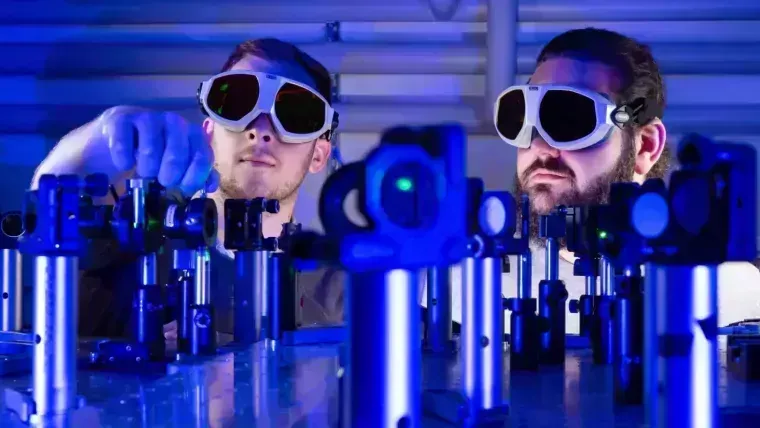
- Light
Published: | By: Angelika Schimmel, English translation by Gleb Chupakhin
Either 1 or 0. Either there is an electric current flowing or there is not. In electronics, everything has been governed using the binary system until now. Electrons already generate and transmit information quite quickly and effectively; they also perform various switching functions. But these processes could be even faster: Paul Herrmann and Sebastian Klimmer from Friedrich Schiller University Jena have proven it. The two doctoral students at the Institute of Solid State Physics conducted experiments with monocrystalline 2D materials and laser light in which they combined the well-known physical method of frequency doubling of light with a special material property called valley polarization and achieved astonishing results.
When asked about their favorite childhood toy, Paul Herrmann and Sebastian Klimmer do not have to think long. They both unanimously answer: the Lego building set. The best thing about it, they explain in agreement, was that there were so many possibilities for combinations. The two have preserved their enthusiasm for building sets, but they have been working with a construction set of a completely different scale for their doctoral research: with so-called 2D materials, which they break down into atomic layers and then manipulate using "valleytronics".
Paul Herrmann and Sebastian Klimmer are conducting their research at the Institute of Solid State Physics at the University of Jena in the "Ultrafast Optical Spectroscopy" research group led by Junior Professor Dr. Giancarlo Soavi. Their goal is to discover new materials and technical possibilities that can significantly enhance the speed of information processing and transmission using modern electronics.
The two doctoral candidates utilize light as a tool for their research – a significant topic not just in physics at the University of Jena – as well as the high-tech building blocks of 2D materials. "These materials, consisting of only a single layer of atoms, possess outstanding optical properties that make them highly interesting for research," explains Paul Herrmann, who has been part of Giancarlo Soavi's research group for a year. “In 2004, Nobel laureates Geim and Novoselov succeeded in producing the first two-dimensional layer of carbon atoms, known as graphene. Since then, many more 2D materials have been discovered by scientists worldwide," adds Sebastian Klimmer. "Theoretical models also predict that there should be around 1,800 of them. That is practically our modern Lego set, whose building blocks offer us infinite possibilities for combinations."
Alternately Manipulating Local Extrema with Light
The two physicists from Jena have chosen tungsten diselenide, which belongs to the group of transition metal dichalcogenides, from among the materials of the construction set. "This particular semiconductor material has local extrema in its electronic band structure, called valleys, which we can manipulate using light," explains Paul Herrmann regarding their choice.
The young researchers work successfully with these materials in the laboratory. "We bombard the material with a circularly polarized laser. This can be done in two different directions, allowing us to determine which valley we excite electrons in," explains Herrmann. "This phenomenon of valley polarization - the state in which one valley is more excited than the other - can be exploited to encode, manipulate, and read information," Klimmer further elaborates.
At the same time, the researchers are taking advantage of the established frequency-doubling effect of "second-harmonic generation," which has been known since the 1960s. "We use an infrared laser with a wavelength of 1,500 nanometers. With this, we can operate the frequency doubling in tungsten diselenide resonantly with two photons, thus further amplifying the induced valley polarization," says Herrmann of the complex process. "Furthermore, the use of frequency doubling allows us to significantly simplify the separation of the exciting light and the signal of interest, which is located at 750 nanometers, i.e. half the wavelength or double the frequency," adds Klimmer.
With Light, Electronics Will Become 1000 Times Faster
Paul Herrmann summarized the research results from Jena: "So far, the binary system, whereby information is transmitted by turning the current on or off, has been used in electronics. A transistor can perform about one billion calculations per second. By switching the electronics with light instead of electricity, we can increase this to one trillion calculations per second. That means our system is 1,000 times faster than conventional electronics." This makes the solution potentially interesting for various areas of optoelectronics and technology.
Herrmann and Klimmer reported their research work on "Nonlinear Optical Coherent Generation and Reading of Valleys in Atomically Thin Semiconductors" in a new paper, already available online, published in the journal "Small.” What makes this work from Jena unique is the combination of the method of resonant two-photon frequency doubling and valley polarization.
2D-Materials Research Is Booming at the University of Jena
Sebastian Klimmer and Paul Herrmann believe that it will take several more years before the new insights on 2D materials and technical solutions from Jena can be applied on a larger scale. Such is the way of fundamental research. However, it's not just the two middle-of-their-twenties researchers who are convinced of the opportunities presented by these new high-tech materials. At the Institute of Solid State Physics at the University of Jena, approximately 15 physicists, including both men and women, are currently studying 2D materials in Professor Giancarlo Soavi's research group. They are also involved in the work of the SFB 1375 "NOA - Nonlinear Optics down to Atomic Scales," whichhas recently been extended by the DFG until 2027. The Institute of Solid State Theory and Optics has been a collaborative partner, as well as the Graduate School "Tailored Meta-Surfaces - Generation, Programming, and Detection of Light," where Klimmer also works. Furthermore, 2D materials play an important role in several other institutes at the University's Abbe Center of Photonics.
Original-Publikation:
P. Herrmann, S. Klimmer, T. Lettau, M. Monfared, I. Staude, I. Paradisanos, U. Peschel, G. Soavi, "Nonlinear All-Optical Coherent Generation and Read-Out of Valleys in Atomically Thin Semiconductors," Small, https://doi.org/10.1002/smll.202301126External link (2023).